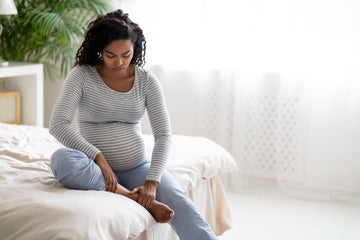Bringing a new life into the world is a beautiful and transformative journey. Pregnancy, while joyous, often comes with its share of challenges – body changes, hormonal changes, and discomforts like restless leg syndrome. Restless leg syndrome during pregnancy can be extremely frustrating, disrupting the much-needed rest and relaxation of a soon-to-be mother.
Luckily, there are ways to alleviate the symptoms of restless leg syndrome while pregnant to find comfort. In this article, we will take a closer look at how to get rid of restless leg syndrome while pregnant, including the causes , gentle exercises and stretches for symptom relief, and the benefits of massage to ensure better sleep.
What Causes Restless Leg Syndrome During Pregnancy?
Restless leg syndrome is characterized by the irresistible urge to move the legs and is often accompanied by uncomfortable sensations like tingling, crawling, or aching. It can affect anyone, but pregnant women are at a higher risk of experiencing restless leg syndrome. Pinpointing an exact reason for experiencing it during pregnancy is almost impossible, but it is believed to be influenced by several factors, including:
- Hormonal changes: Fluctuations in hormones, particularly an increase in estrogen and progesterone, can trigger restless leg syndrome symptoms.
- Iron deficiency: Pregnant women are more prone to iron deficiency, which can exacerbate restless leg syndrome symptoms. Iron is essential for proper muscle function, and a deficiency may contribute to leg discomfort.
- Pressure on nerves: As the baby grows, the uterus can pressure the nerves in the pelvis and legs, leading to discomfort and restless leg syndrome symptoms.
- Poor circulation: Pregnancy can affect blood circulation, and reduced blood flow to the legs may intensify restless leg syndrome sensations.
How to Help Restless Leg Syndrome During Pregnancy
Understanding the potential causes of restless leg syndrome is only the first step in finding out what to do for restless leg syndrome when pregnant. Finding relief isn’t always easy for an expecting mom, but there are some strategies that may help you figure out how to help restless leg syndrome during pregnancy. These strategies include gentle exercises, stretching, massage, and ergonomic positions that may bring relief.
Gentle Exercises and Stretches
When the body changes during pregnancy, gentle exercises and stretches may be what helps with restless leg syndrome relief and loosen tight muscles in the legs, thighs, and calves. These low impact exercises and stretches increase blood flow and promote relaxation – something every pregnant woman feels like she needs more of. Here are three gentle exercises and stretches to try if you have restless leg syndrome while pregnant:
- Ankle rotations: While sitting or lying down, gently rotate your ankles in a circular motion, clockwise, then counterclockwise. This simple exercise can improve blood flow and alleviate unwanted sensations in the legs.
- Calf stretches: Stand facing a wall and place your hands against it for support. Step one foot back while keeping it flat on the floor and bend the front knee slightly. This stretch targets the calf muscles, which can help relieve discomfort associated with restless leg syndrome.
- Yoga and prenatal exercise: Engaging in prenatal yoga or gentle exercises designed for expectant mothers can help improve flexibility, blood circulation, and overall comfort. Always consult with your healthcare provider before starting a new exercise regimen during pregnancy.
Massage for Restless Leg Syndrome While Pregnant
Massage may be what helps with restless leg syndrome. Regular massages can help relax muscles, reduce tension, and improve blood circulation. Pregnant women should seek out certified prenatal massage therapists who are trained in working with expectant mothers to ensure safety and comfort. With a prenatal massage routine and other self-care practices, relaxation can be achieved during pregnancy.
Another option to consider for managing restless leg syndrome while pregnant is an at-home massage chair. These chairs provide various types of massage and can help you find body pain relief during pregnancy from the comfort of home. Some chairs may also include zero gravity positions that can help reduce pressure on the legs and alleviate discomfort from restless leg syndrome. How often can you use a massage chair while pregnant? This may vary, so it’s best to consult with your doctor for their guidance.
Ergonomic Considerations for Pregnant Women
Creating a comfortable environment is crucial for managing restless leg syndrome while pregnant. Basic ergonomic considerations can help provide relief, especially when massage or exercises are not easily achievable. Some simple ways to achieve ergonomic comfort during pregnancy include using pillows to support your legs and elevate them slightly, investing in a proper mattress that supports the body, and using a pregnancy pillow can help facilitate a stress-free and relaxing sleep environment.
Lifestyle Adjustments for Restless Leg Syndrome While Pregnant
Finding what helps with restless leg syndrome may require lifestyle adjustments – especially when pregnant. Small changes can greatly impact how your body responds to pregnancy changes and reduce the discomfort caused by restless leg syndrome.
Some lifestyle adjustments to consider are:
- Maintain a balanced diet: Ensure you are getting enough iron and other essential nutrients through a well-balanced diet or supplements prescribed by your healthcare provider.
- Stay hydrated: Proper hydration can help prevent muscle cramps and reduce the severity of restless leg syndrome symptoms.
- Avoid triggers: Identify and avoid potential triggers for restless leg syndrome while pregnant, such as caffeine and nicotine.
- Manage stress: High stress levels can intensify restless leg syndrome symptoms. Practice relaxation techniques like deep breathing, meditation, or prenatal yoga to help reduce stress.
- Stay active: Regular, gentle exercise can improve circulation and reduce the severity of RLS symptoms. Consult with your healthcare provider for suitable exercises during pregnancy.
Relief Can Be Possible For Restless Leg Syndrome When Pregnant
Experiencing restless leg syndrome during pregnancy can be challenging, but with the right combination of gentle exercises, massage, and lifestyle adjustments – it is manageable. Taking proactive steps to address restless leg syndrome while pregnant can help you find relief and relaxation. Whether you purchase an in-home massage chair, reduce stress or change your diet, you can tackle how to get rid of restless leg syndrome while pregnant and find solace during your pregnancy.
Disclaimer: This content is not medical advice. Please consult with your health care professional when considering implementing changes to your health or workout routines to ensure it’s compatible with your needs.





